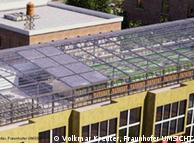Food routinely travels across the planet by train,
plane and ship, but are all these 'food miles' necessary? Urban farms could put
a substantial amount of fresh produce on our tables without the long journeys
Nowadays it's no surprise to find Californian lettuce in a New York grocer or New Zealand
onions in a German supermarket.
A massive logistical operation swings into action every day in
industrial societies, just to supply cities with food. Yet some say
cities could be doing a lot more to feed themselves.
Volkmar Keuter of the Fraunhofer Institute for Environmental, Safety
and Energy Technology in the German town of Oberhausen says cities are
full of unused potential to grow food.
"You might have some kind of production going on underneath a roof.
Certain industrial installations that produce heat could be used as a
greenhouse in winter," he told Deutsche Welle.
"Or you might have office buildings. Offices often have large server
rooms that produce heat as they cool the computers. That heat could be
used as well."
 Hydroponic systems already exist on the New York skyline
Hydroponic systems already exist on the New York skyline
Circulation saves resources
Keuter is an advocate for urban farming. Especially when it comes to
using the spaces – and outputs – that we frequently consider 'waste.'
Take sewage. Treated properly, this could be used to fertilize rooftop farming operations.
"You could use the waste water that flows from buildings anyway, and
then treat and sanitize it so the roots of the plants get bacteria-free
water," he said.
This implies some significant up front investments, but there are savings to be had as well.
"If you could re-claim the nutrients in the waste water – the
phosphorus, nitrogen and potassium – you would only need to add a very
small amount of fertilizer."
One of the best ways to grow vegetables in cities is with hydroponic
systems – using synthetic granulates or fibers instead of soil and
recycling water and other nutrients. This has downsides - it can be
expensive and energy intensive. But Keuter says there are plenty of
advantages at hand.
Hydroponic growers can use the electrical conductivity of their
plants' water to measure its nutrient content, allowing growers to
maintain optimal growth conditions.
"The plants can be fertilized much more efficiently than with
traditional farming, where you often dump too much fertilizer on the
plants. In effect, you can guarantee a harvest 10 or 20 times more than
traditional farming. You can grow a lot of plants in a very small
space," he said.
Measuring nutrients
 Another advantage of a hydroponic system is that
the flower pots are very light, since the plants don't need any earth,
which is important because most roof structures can't support much
weight.
Another advantage of a hydroponic system is that
the flower pots are very light, since the plants don't need any earth,
which is important because most roof structures can't support much
weight.
Although most urban roofs can't support the weight of a farm, Keuter
says a surprising amount of space is suitable for growing food. He
estimates that there are 36,000 hectares available on Germany's rooftops
alone.
That's around three times more space than all the greenhouses in the Netherlands.
"Depending on whether you're going for quantity or quality, you could
produce around 40 tons of vegetables a year on 1,000 square meters of
rooftop. That could be in lettuce or tomatoes, but it could also be in
beans or zucchini," Keuter said.
Endless possibilities
With space for traditional agriculture being reduced worldwide, some
scientists believe it might also be worth considering building
multi-story greenhouses like skyscrapers.
Though they would need artificial lighting, modern LED technology
already hints at the energy-saving possibilities in this regard.
Cologne architect Stefan Schmitz, who works on developing green
cities in China, is enthralled by the idea of bringing food production
closer to people.
"What I like about it is that you could also introduce it to children
and students," Schmitz told Deutsche Welle. "You could show them what
agriculture is – how you harvest, how the produce grows."
Urban farming already has a foothold in the United States and China.
While it is not usually on rooftops, it is still accessible for town
populations. Schmitz has a firm vision for how he would like to see it
take hold globally.
"You could be doing your shopping in the mall, for clothes or
whatever," he explains. "Then you get a basket and you walk though a
greenhouse on the roof to fill it up. So it's self-service, but not all
packaged like in a supermarket. It's straight from nature."
Author: Fabian Schmidt / bk
Editor: Nathan Witko
Editor: Nathan Witko

No comments:
Post a Comment